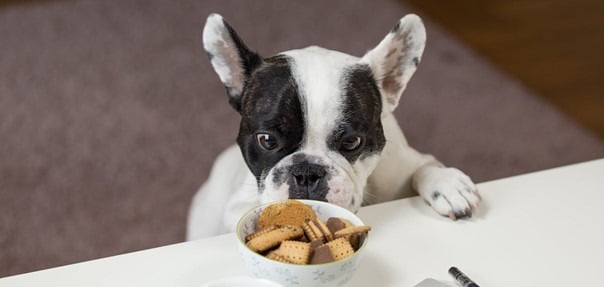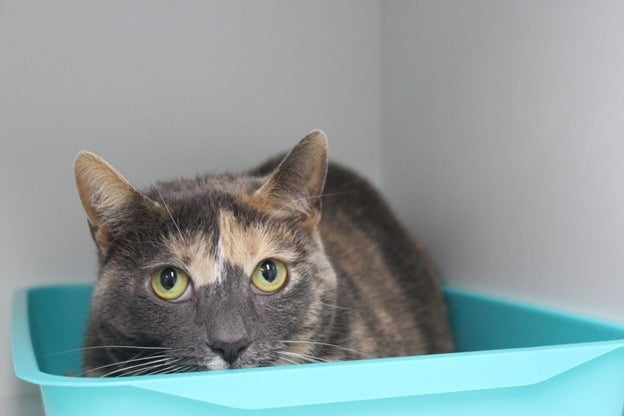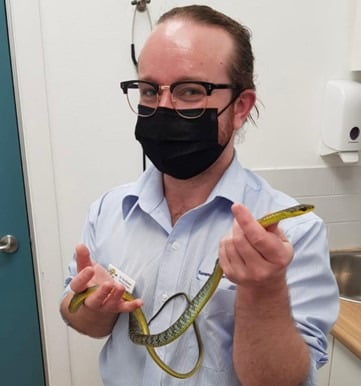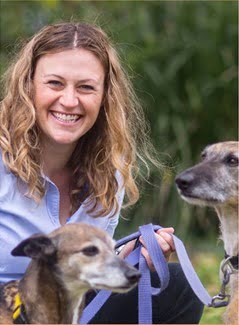Keeping you informed
Newsletter September 2022

Avoid foreign object ingestion in pets!
Spring is well underway as we enter the month of October, which means warmer weather, baby birds, and new flowers blooming! With the onset of spring, our practice is seeing an influx in skin allergies and tick paralysis cases as pets spend more time outdoors.
In addition to itchy skin, ear infections and ticks, our vets treated a few foreign body cases over the last month, including our ‘Pet of the Month’ winner, Fortune Zhang, who is happy and healthy after eating an item he definitely shouldn’t have!

Our Pet Behaviour Consultant Katie Bedrossian has also written an in-depth article on ‘How to manage and prevent your dog swallowing non-food items’, which is an excellent read for any dog owner. It delves into our furry friends’ natural scavenging instincts, and how we can prevent these negative behaviours from causing issues in the long term.
No matter the time of year, if your dog or cat has smelly breath and tartar present, your pet may need a dental scale and polish performed. Dr Amy Howe and Dr Gretta Howard, have co-authored an article about exactly what is involved in their article ‘My pet needs a dental procedure’.
Pet Of The Month: Fortune Zhang

Fortune presented to us as an interesting case in need of some diagnostic investigation. He had a “foreign body”, the term used to describe something being in your pet that shouldn’t be there. Common items consumed by pets include socks, rubber bands, skewers or small toys. Most people would immediately picture a mischievous puppy getting his nose into the trash can or dirty laundry basket, however cats can also be culprits!
Occasionally, these items will pass naturally through the faeces, although this is not always the case. For Fortune, the diagnostics included blood testing and x-rays and he was treated with intravenous fluid therapy and eventually a surgical procedure known as an exploratory laparotomy to remove the foreign body, which turned out to be a piece of……insert drum roll……steel wool! In this case, curiosity could have killed the cat, but Dr Pip Wines acted promptly and removed it successfully. Lucky boy!
We are so happy to see Fortune back to his usual self, and can’t commend him enough on being so brave throughout the whole ordeal! We have awarded him our Pet of the Month award for September.
If you are concerned for your pet, or think they may have ingested a foreign body, be sure to call us urgently to make an appointment.
Socks, Rocks & Jocks! Oh My!
How to manage and prevent your dog swallowing non-food items
Author: Katie Bedrossian – Pet Behaviour Consultant

Dogs are opportunistic scavengers by nature, taking every opportunity to scavenge (explore, investigate and consume). This is how they domesticated themselves, hanging around human camps, eating scraps of food and sharing our meals rather than hunting for themselves.
Scavenging is designed for seeking out and consuming food items. Unfortunately, some of our canine friends extend this opportunistic scavenging to objects easily accessible in the home or on walks.
Why do dogs seek out these other items to eat?
- Comfort seeking due to excitement, stress or frustration. It will often be items that smell of the people they trust and also certain textures (depending on what they have personally found comforts them).
- Practise searching for and putting the item in their mouth. The items have commonly been in reach, particularly during puppyhood, meaning investigating them has been regularly practised.
- The value of the item has been heightened. This can be due to getting some human attention (eye contact, movement towards, talking to) being received when they grab the item, a chase game (you want the item, therefore they want it too) and/or the item being removed without a positive (develops a ‘I must keep this item or it will be taken away for no reward’ type mentality).
- Resource guarding. When the value of the item has been heightened, resource guarding can develop. This is the tendency to protect something that they consider valuable. Many people think of guarding as tense bodies, growling, snapping and biting. However, swallowing these items is another way for a dog to guard things (if it is in my stomach, you can’t have it!).
Click on the link to learn more about preventing your dog swallowing non-food items.
Help! My cat keeps vomiting up hairballs!
Author: Freya Britt-Lewis – Customer Care & Pet Health Care Writer

When your family cat has a hairball (known officially as a trichobezoar), the problem can inevitably be more complicated than a few thrown up slimeballs and unpleasant cleanups. Frequent hairball vomits can sometimes indicate your cat has an underlying problem that your vet needs to investigate further.
In most healthy cats during grooming, when hair gets caught on the rough tongue and swallowed during grooming, it should be transferred through the stomach and intestines, then out of the body via the faeces.
If your cat is vomiting hairballs frequently, it is important to rule out an underlying cause in these cases.
If you notice your feline family member is bringing up hairballs, bring them in for a veterinary consultation.
Causes
The cause of frequent hairball production can range from:
- Long-haired cats ingesting excessive amounts of hair due to inadequate or intolerance of brushing
- Intestinal obstruction
- Partial or complete gastro-intestinal obstruction can prevent the normal passage of hair through the digestive tract
- Foreign body ingestion or even an oversized hairball that cannot pass through the gastrointestinal tract can in turn cause more hairballs to be vomited by the cat
- A growth (cancer) in the gastro-intestinal tract can prevent hair passing through
- Delayed gastric emptying disorders
- If the gut motility is slow or stomach emptying into the duodenum is delayed for some reasons, hairballs are more common
- Dietary intolerance
- Like humans, cats can develop an intolerance to their diet which can cause chronic vomiting and hairball production
- Inflammatory bowel disease
- Inflammation of the bowel can interfere with nutrient digestion and absorption, leading to abnormal hair accumulation in some cases
- Overgrooming
- Stress and/or obsessive compulsive disorder can lead to overgrooming
- Licking is a form of itch-relief in cats, so hairballs can sometimes indicate allergic skin disease caused by food, environment or flea allergy dermatitis
- Internal parasites
- Worms in the gastrointestinal tract can result in hairball formation as they interfere with the normal passage of ingesta through the gut
Click on the link to read the other causes, diagnostics and preventions around cats and hairballs.
My pet needs a dental procedure
Co-Authors: Dr Amy Howe and Dr Gretta Howard

Pet dental disease is one of the most common problems seen by veterinarians, with recent studies showing at least 70% of cats and dogs have some degree of dental disease by the age of 3. This can often go unnoticed, as it is very rare for dental disease to cause a pet to stop eating, or to show that they may have oral discomfort or pain.
Home dental care forms an important part of slowing the progression of pet dental disease, but often this isn’t enough on its own. Your vet may recommend a dental scale and polish to ensure a complete clean of your pet’s teeth, including those hard-to-reach areas in the mouth. When instigated early in the course of disease, this can prevent dental disease from progressing, leading to a healthy pain-free mouth for your pet!
How do I know if my pet has dental disease?
Some or all of the following signs may be observed:
- Smelly breath
- Discoloured teeth
- Tartar – a yellowy-brown build-up of material firmly attached to the teeth
- Gingivitis – red, inflamed gums with or without bleeding
- Broken teeth
- Reduced ability to chew food or chewing on one side of the mouth only (severe cases)
- Excessive drooling (severe cases)
Many pets are genetically predisposed to periodontal disease (gum disease), which is often painful. Periodontal disease occurs when there is a bacterial infection in the gums that develops with plaque accumulation over time. If plaque is not removed, it will calcify and turn into tartar. This leads to the loss of bone that hold the teeth in the jaw, which causes pain and eventual tooth loss.
Treating dental disease as early as possible gives us the best chance of saving the teeth involved and minimising discomfort.
Click on the link to learn about pet dental procedures.
Turramurra Veterinary Hospital: Meet our visiting veterinary specialists!
Author: Freya Britt-Lewis – Customer Care & Pet Health Writer
Turramurra Veterinary Hospital has a wonderful team of veterinary specialists that are available to be called upon when needed to assist with diagnostic ultrasound, endoscopic procedures, x-ray reporting and challenging surgical cases. Registered veterinary specialists have undergone several years of additional training in their chosen specialty. Our Veterinary Team is regularly supported in managing the more challenging surgical and medical cases with their skills and expertise. Our relationship with veterinary specialists enhances patient outcomes and assists in clinical decision making.
Dr Eugene Buffa
BVSc MmedVet Surgery
Small Animal Surgical Specialist
Dr Eugene Buffa has been a visiting Specialist in Small Animal Surgery at Turramurra Veterinary Hospital for over five years, with over 20 years of experience as a specialist. Dr Eugene has extensive experience, having practised in England, South Africa, and Australia. His area of expertise includes canine cruciate disease, canine hip replacement surgery, fracture repair, reconstructive surgery and complex wound management. If your pet is coming in for a ‘TPLO’ (Tibial Plateau Levelling Osteotomy) or ‘MPL’ (Medial Patella Luxation surgery), they will most likely be performed by Dr Eugene. He has published veterinary papers, presented at international congresses and researched wound healing mechanisms. As an experienced and passionate surgeon, we appreciate being able to entrust our patients with Dr Eugene Buffa when they are in need of specialist surgery.
Dr Anna Dengate
BMedSc BVSc FANZCVS
Small Animal Medicine Specialist
Small Animal Medicine Specialist Dr Anna Dengate, who set up The Vet’s North – a mobile specialist consultancy service, regularly performed diagnostic ultrasounds at Turramurra Veterinary Hospital for medical cases. She has a special interest in minimally invasive procedures such as abdominal ultrasonography and echocardiography, and has presented at several local and international conferences. Dr Anna’s compassionate and knowledgeable approach to patient care is complementary to our own, and we are delighted to have her as part of our team of regular specialists.
Dr David Collins
BVSc FANZCVS
Small Animal Medicine Specialist
Small Animal Medicine Specialist, Dr David Collins, has had over 10 years experience in specialist referral medicine. We often call on Dr Dave for complex medical cases in need of diagnostic ultrasound. David is a Director at Northside Veterinary Specialists, and has been an examiner for the Australian and New Zealand College of Veterinary Scientists on several occasions and presented at international conferences. Dr Dave Collins’ thorough knowledge and care of his patients makes him a valuable asset to our team of visiting veterinary specialists.
Dr Robert Nicholl
BSc(Vet) BVSc Diplomate ACVR
Specialist in Diagnostic Imaging
Diagnostic Imaging Specialist, Dr Robert Nicholl, provides a prompt specialist x-ray interpretation service as well as diagnostic ultrasound. Dr Rob has extensive knowledge and experience in the Veterinary industry, having graduated from the University of Sydney in 1989. In fact, several of our vets were taught by Dr Rob at university as he has been extensively involved in undergraduate and postgraduate teaching in both Australia and the United States. Dr Rob has researched and published papers in veterinary radiolography, ultrasound, MRI, and CT. With so much experience, our Vet Team is always grateful to learn all they can from Dr Rob in order to strengthen our own knowledge in diagnostic imaging.
Staff Profile: Dr Tee Brown – Veterinarian

What inspired you to gain your qualifications and work as a veterinarian?
I share the deep love of animals that many in the veterinary industry possess. When my beautiful cat that I grew up with suddenly passed away when I was 9 years old, I knew that I wanted to help save cats. It is in my nature to want to be caring and helpful, and I have a problem solving mindset, so becoming a vet seemed the perfect way to marry my personality and my interests.
You have additional skills in exotic pet medicine and surgery. What drew you into this area of veterinary science?
In short, it fascinates me! Exotics refers to small mammals (rabbits, guinea pigs, rats, mice), reptiles, amphibians and birds. There is so much to know given the diversity of species and their unique needs. This variety means that detailed medical knowledge cannot be taught about every species in veterinary school. I’m passionate about providing the best quality care to these incredible creatures and I’m constantly striving towards this goal.
What do you enjoy about working at Turramurra Vet Hospital?
My favourite thing is having fantastic co-workers and being part of a caring team with such a diverse skill set. This makes every day just that much better. I really enjoy being able to collaborate with my fellow vets on the more challenging cases. That, plus visiting specialists, allows me to offer gold standard care to my patients which I really value.
Tell us a little bit about your own pets.
My pride and joy is Leia, my Bengal cat, who I adopted from an older couple that could no longer care for her. She’s just turned 17, is deaf, and has the loudest meow I’ve ever heard! I also have three cheeky guinea pigs – Carrie, Hamlet, and Matilda, who each have distinct personalities (Hamlet is the smallest and the bravest!). My pets’ idiosyncrasies and hijinks bring me joy every day.
Ask the Vet!
Author: Dr Tee Brown – Veterinarian

1. What diet should we be feeding our newly adopted guinea pig?
Congratulations on your new piggie! A guinea pig’s daily diet should be unlimited hay and 1-2 cups of dark green leafy vegetables and fresh herbs. Like humans, guinea pigs can’t make their own vitamin C, so they require some vegetables high in vitamin C such as broccoli, cabbage, brussels sprouts, or small amounts of capsicum. You might be surprised but guinea pigs only require 1-2 tablespoons of pellets and they must be the type without fruits or grains mixed in. The best treats are occasional very small amounts of fresh fruit such as apple, or root vegetables such as carrot – avoid any ‘guinea pig’ treats from the store which usually contain grains or dried fruit – these are very high in sugar and are dangerous for guinea pig gut health.
Editor’s comment: Oxbow or Vetafarm are examples of suitable high quality guinea pig pellets. These can be ordered from Turramurra Veterinary Hospital.
2. I know that dogs and cats need dental care to remain healthy, is it the same for rabbits?
When it comes to bunnies, prevention is definitely better than cure. The best way to avoid dental disease in rabbits is to provide hay at all times. This is necessary so that they wear down their teeth because in rabbits, the teeth continue to grow throughout their life. Due to this continuous tooth growth, dental problems are extremely common and if a problem arises it must be fixed promptly! Signs such as a new preference for soft foods only, slobbering, teeth grinding or not eating as much as usual, could indicate dental disease. Should you notice any of the above clinical signs in your rabbit, book a veterinary consultation so that the teeth can be examined properly.
3. What are the pros and cons of wing clipping in indoor birds?
Wing clipping is a hot topic amongst bird fanciers and avian veterinarians so I don’t want to ruffle any feathers! Wing clipping does not fully prevent flight but it can minimise lift and flight speed, potentially reducing high-speed impact injuries. Wing clips, however, can cause problems such as fall injuries which are very common and in addition to this, birds may not be able to escape situations that they perceive as a threat. An assessment of individual household risks would be the best guide as to whether wing clipping is the right choice for an indoor bird. I am more than happy to discuss this with you further to determine the best option for your bird during a veterinary consultation.
We hope you have enjoyed our newsletter and would love to hear from you!
We are always happy to receive feedback from our clients, so feel free to send an email to Kelly Lawrence by emailing manager@turramurravet.com.au as we always strive to improve our service.
Thank you! Best wishes, your locally family-owned and independent Turramurra Veterinary Hospital team.





